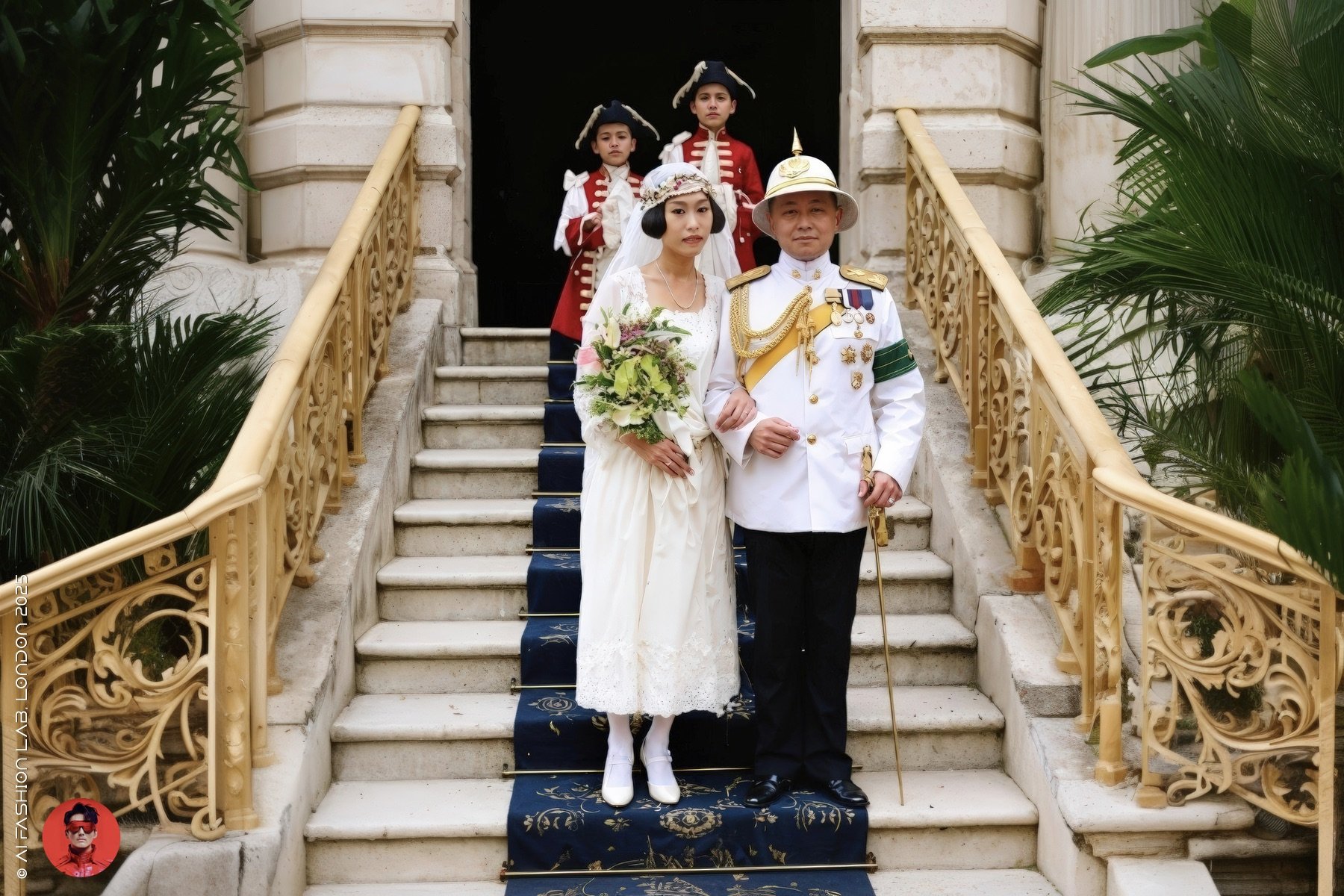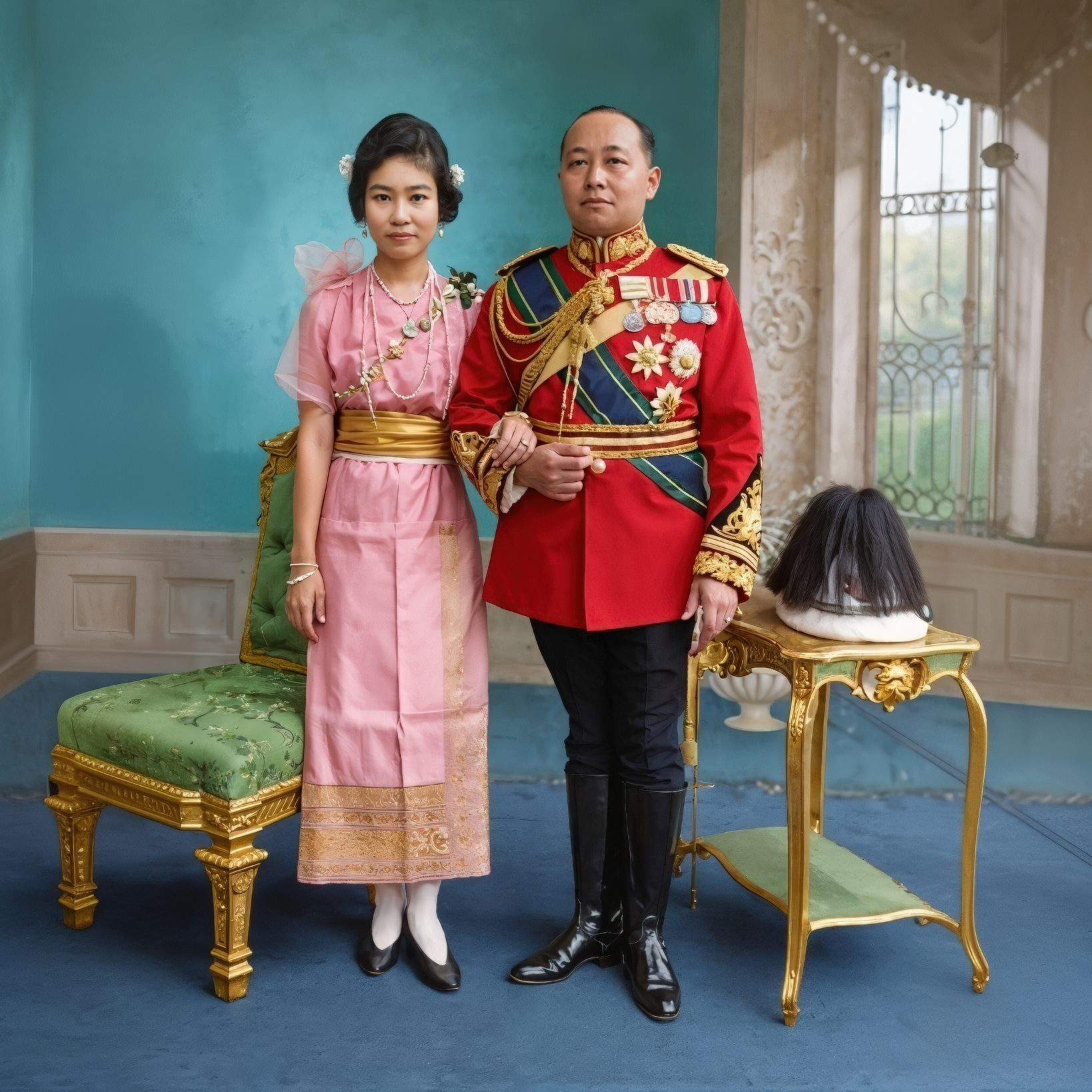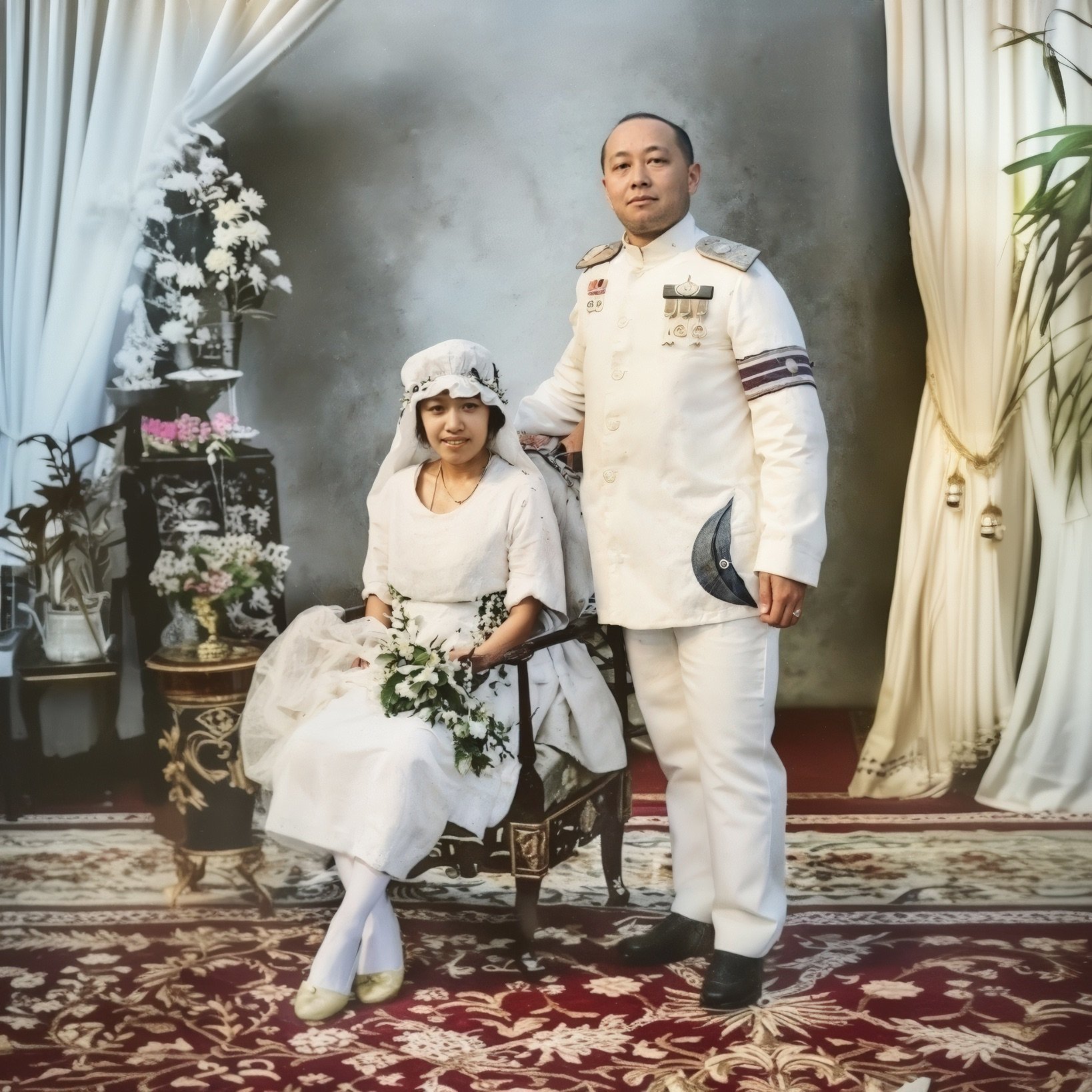พระมเหสี พระสนมเอก และพระคู่หมั้นในรัชกาลที่ ๖ กับแฟชั่นชุดแต่งงานแบบตะวันตก
พระมเหสี พระสนมเอก และพระคู่หมั้นในรัชกาลที่ ๖ กับแฟชั่นชุดแต่งงานแบบตะวันตก
ในรัชสมัยของพระบาทสมเด็จพระมงกุฎเกล้าเจ้าอยู่หัว (รัชกาลที่ 6) ราชสำนักสยามได้เห็นการเปลี่ยนแปลงอย่างสำคัญในด้านแฟชั่นของพระราชพิธี โดยเฉพาะอย่างยิ่ง “พิธีอภิเษกสมรส” ซึ่งมีการนำแบบแผนของชุดเจ้าสาวตะวันตกสีขาวมาใช้กับสตรีฝ่ายในในราชวงศ์ไทย ถือเป็นการเปลี่ยนผ่านทั้งในเชิงสุนทรียะและอุดมการณ์ ที่ผสานความรักสมัยใหม่ ความงามแบบยุโรป และอัตลักษณ์แบบชาติไทยเข้าไว้ด้วยกัน ในขณะที่เจ้าสาวสวมชุดขาว เจ้าบ่าว—ไม่ว่าจะเป็นสามัญชนหรือกษัตริย์—ต่างสวมเครื่องแบบทหาร อันเป็นสัญลักษณ์แห่งศักดิ์ศรี หน้าที่ และความเป็นชายในอุดมคติของศตวรรษที่ 20
คอลเลกชันภาพ AI ชุดนี้ได้รับการลงสีใหม่และบูรณะด้วย Flux Kontext Pro จากภาพถ่ายต้นฉบับขาวดำ บทความนี้จะพาผู้อ่านไปรู้จักกับสตรี 5 พระองค์ผู้มีความเกี่ยวข้องทางพระราชหฤทัยกับพระบาทสมเด็จพระมงกุฎเกล้าฯ โดยในจำนวนนี้มี 2 พระองค์ที่ได้รับการหมั้นหมายอย่างเป็นทางการ และอีก 3 พระองค์ที่ได้รับพระราชพิธีอภิเษกสมรส ภาพถ่ายซึ่งได้รับการลงสีใหม่เหล่านี้ช่วยถ่ายทอดเรื่องราวแห่งความรัก อำนาจ และการเปลี่ยนผ่านของวัฒนธรรมแฟชั่นในราชสำนักไทย
💍 1. พระเจ้าวรวงศ์เธอ พระองค์เจ้าวัลลภาเทวี – คู่หมั้นพระองค์แรก (พ.ศ. 2463) (ค.ศ. 1920)
พระองค์เจ้าวัลลภา พระนามเดิม หม่อมเจ้าวรรณวิมล และได้รับการสถาปนาเป็น พระวรกัญญาปทาน พระองค์เจ้าวัลลภาเทวี พระบาทสมเด็จพระมงกุฎเกล้าฯ ได้ทรงหมั้นกับ พระองค์เจ้าวัลลภาเทวี อย่างเป็นทางการเมื่อเดือนพฤศจิกายน พ.ศ. 2463
ภาพถ่ายที่ได้รับการสร้างสรรค์ใหม่และลงสีด้วย AI แสดงให้เห็นฉลองพระองค์ไทยประยุกต์ที่ผสานกลิ่นอายแฟชั่นตะวันตกยุคอาร์ตเดโค — ผ้านุ่งโจงกระเบนสีม่วงอ่อน เสื้อคลุมโปร่งสีชมพูปักลาย พร้อมเครื่องประดับศีรษะ bandeau และสร้อยคอไข่มุกแบบตะวันตก ขณะที่พระบาทสมเด็จพระมงกุฎเกล้าฯ ฉลองพระองค์เครื่องแบบทหาร สะท้อนพิธีการทางราชการที่รองรับสถานะของพระองค์ในฐานะพระคู่หมั้น
พระองค์เจ้าวัลลภาเทวี ไม่เคยได้สวมชุดเจ้าสาวสีขาวตามแบบราชพิธีสมัยใหม่ เนื่องจากการหมั้นนี้ถูกถอนในเดือนมีนาคม พ.ศ. 2464 โดยมีคำอธิบายเพียงว่า “พระราชอัธยาศัยไม่ต้องกัน” ต่อมา พระองค์ถูกจำขังในเขตพระราชฐานอย่างเงียบ ๆ ตลอดรัชกาลที่ 6
📸 ภาพแรก: พระองค์เจ้าวัลลภาเทวีในฉลองพระองค์ประยุกต์ร่วมสมัย หรือสไตล์ผสมผสาน นั่งเคียงคู่รัชกาลที่ 6 ซึ่งแต่งเครื่องแบบขาว สื่อถึงช่วงเวลาที่ทั้งสองยังคงอยู่ในสถานะคู่หมั้นภายใต้ขนบของราชสำนัก
💍 2. พระนางเธอลักษมีลาวัณ – คู่หมั้นพระองค์ที่สอง (พ.ศ. 2464) (ค.ศ. 1921)
หม่อมเจ้าวรรณพิมล วรวรรณ เป็นพระขนิษฐาต่างชนนี (น้องสาวต่างแม่) ของ พระองค์เจ้าวัลลภาเทวี ต่อมาพระบาทสมเด็จพระมงกุฎเกล้าเจ้าอยู่หัวโปรดเกล้าฯ พระราชทานนามใหม่ เป็น หม่อมเจ้าลักษมีลาวัณ พระบาทสมเด็จพระมงกุฎเกล้าฯได้ทรงหมั้นกับหม่อมเจ้าวรรณพิมล เมื่อวันที่ 8 กันยายน พ.ศ. 2464 แต่หลังจากนั้นเพียง 1 เดือน 19 วัน พระบาทสมเด็จพระมงกุฎเกล้าฯกลับทรงเปลี่ยนพระราชหฤทัยไปอภิเษกกับสตรีสามัญชนแทน
แม้จะไม่ได้รับพระราชพิธีอภิเษกสมรส แต่เมื่อวันที่ 27 สิงหาคม พ.ศ. 2465 พระบาทสมเด็จพระมงกุฎเกล้าฯ ได้มีพระบรมราชโองการสถาปนาเป็น พระนางเธอลักษมีลาวัณ อย่างเป็นทางการ เสมือนเป็นรางวัลแห่งพระเมตตา และเพื่อรักษาพระเกียรติของราชนิกุลฝ่ายวรวรรณ
ภาพถ่ายที่ได้รับการลงสีนี้แสดงให้เห็นพระนางในฉลองพระองค์ไทยสีชมพูอ่อน โจงกระเบนไหมสีชมพูทอง ทับด้วยเข็มขัดทองและเครื่องประดับมุกแบบราชสำนัก ยืนเคียงคู่รัชกาลที่ 6 ซึ่งฉลองพระองค์เครื่องแบบทหารสีแดงเต็มยศ ติดสายสะพายและเหรียญตราอย่างเป็นทางการ ทั้งคู่ยืนบนฉากหลังแบบยุโรป ตอกย้ำภาพลักษณ์ของราชสำนักไทยที่ผสานขนบตะวันตกในยุคหลังสงครามโลกครั้งที่ 1
📸 ภาพที่สอง: สะท้อนความสง่างามของพระนางเธอลักษมีลาวัณในชุดไทยสีชมพูยืนเคียงพระมหากษัตริย์ในเครื่องแบบทหารสีแดง สื่อถึงสถานะคู่หมั้นที่ได้รับการประกาศอย่างเป็นทางการ แม้จะมิได้มีพระราชพิธีอภิเษกสมรสตามมา
👰🏻 3. พระสุจริตสุดา – พระสนมเอก (พ.ศ. 2464) (ค.ศ. 1921)
หลังจากทรงถอนหมั้นกับสองพระองค์ก่อนหน้าไม่นาน พระบาทสมเด็จพระมงกุฎเกล้าฯ ได้อภิเษกสมรสกับ เปรื่อง สุจริตกุล อดีตนางสนองพระโอษฐ์ของอดีตพระวรกัญญาปทาน และเป็นพี่สาวของพระนางเจ้าอินทรศักดิศจี เมื่อวันที่ 27 ตุลาคม พ.ศ. 2464 ถือเป็นสุภาพสตรีสามัญชนคนแรกในประวัติศาสตร์ไทยที่ได้รับการอภิเษกในราชพิธีเต็มรูปแบบ
📸 ภาพที่สาม: พระสุจริตสุดาทรงสวมชุดเจ้าสาวตะวันตกประดับลูกไม้ ปลายกระโปรงยกขึ้นเห็นรองเท้าทอง และมีผ้าคลุมศีรษะสไตล์แค็ป (cap veil) ตามแบบฉบับเจ้าสาวฝรั่งเศสยุคปี 1920 ส่วนพระบาทสมเด็จพระมงกุฎเกล้าฯ ทรงเครื่องแบบทหารเรือ สะท้อนพระราชอำนาจที่ประสานกับภาพลักษณ์ของความทันสมัย แม้ชีวิตคู่จะสั้นนัก แต่ถือเป็นการเลือกด้วยพระราชหฤทัย พระองค์ดำรงสถานะอย่างเงียบสงบจวบจนสิ้นอายุ
👰🏻 4. สมเด็จพระนางเจ้าอินทรศักดิศจี พระวรราชชายา – พระบรมราชินีแห่งรัชกาลที่ 6 (พ.ศ. 2465) (ค.ศ. 1922)
ต่อมาเมื่อวันที่ 12 มกราคม พ.ศ. 2465 พระบาทสมเด็จพระมงกุฎเกล้าฯ ได้ทรงเปลี่ยนพระราชหฤทัย และประกาศอภิเษกสมรสกับ ประไพ สุจริตกุล น้องสาวของพระสุจริตสุดา และได้มีราชทินนามเป็น พระอินทราณี และต่อมาได้รับการยกฐานะเป็น สมเด็จพระนางเจ้าอินทรศักดิศจี พระบรมราชินี พระมเหสีเพียงพระองค์เดียวในรัชกาล และต่อมาได้รับการลดพระอิสริยยศลงเป็น พระวรราชชายา
📸 ภาพที่สี่: ชุดเจ้าสาวของพระองค์ในภาพถ่าย มีลักษณะตามแบบอาร์ตเดโคอย่างชัดเจน ได้แก่ ความยาวที่สั้นกว่าชุดในยุคก่อน การตกแต่งด้วยลูกไม้แบบเรขาคณิต และผ้าคลุมศีรษะแบบฝรั่ง ส่วนพระบาทสมเด็จพระมงกุฎเกล้าฯ ปรากฏในเครื่องแบบสีขาวตามธรรมเนียมราชสำนัก แม้ความสัมพันธ์จะถูกมองว่าไม่ใกล้ชิดนัก แต่พระองค์ทรงดำรงตำแหน่งพระมเหสีอย่างเป็นทางการตลอดรัชกาล
👰🏻 5. พระนางเจ้าสุวัทนา พระวรราชเทวี (พ.ศ. 2467) (ค.ศ. 1924)
ในเดือนสิงหาคม พ.ศ. 2467 เครือแก้ว อภัยวงศ์ นางละครในวัง ได้รับความโปรดปรานจากพระบาทสมเด็จพระมงกุฎเกล้าฯ ขณะฝึกซ้อมบทบาทในละคร จนกลายเป็นผู้ที่ “ได้รับพระราชหฤทัย” ต่อมาไม่นาน เครือแก้ว จึงได้รับการสถาปนาเป็น เจ้าจอมสุวัทนา และได้เข้าพิธีอภิเษกสมรสตามแบบราชสำนักตะวันตก ณ พระที่นั่งบรมพิมาน หลังการอภิเษก เจ้าจอมสุวัทนาได้ประสูติพระธิดา (สมเด็จพระเจ้าภคินีเธอ เจ้าฟ้าเพชรรัตนราชสุดา สิริโสภาพัณณวดี) เพียงสองวันก่อนที่พระบาทสมเด็จพระมงกุฎเกล้าฯ จะเสด็จสวรรคตในวันที่ 26 พฤศจิกายน พ.ศ. 2468 ซึ่งนับเป็นเหตุการณ์สำคัญยิ่งในบั้นปลายรัชกาล
📸 ภาพที่ห้า: พระองค์ปรากฏในชุดเจ้าสาวสไตล์อาร์ตเดโค ปลายกระโปรงปักลูกไม้สลับลวดลาย และสวมหมวก Juliet cap ที่เข้ากับสมัยนิยม ส่วนพระบาทสมเด็จพระมงกุฎเกล้าฯทรงเครื่องแบบทหารสีขาว สื่อถึงทั้งอำนาจและพระราชพิธี
🧵 มรดกแฟชั่นแห่งราชสำนัก
ในช่วงทศวรรษ 1920 ราชสำนักไทยได้รับแฟชั่นตะวันตกในฐานะสัญลักษณ์ของอารยธรรม ความงาม และความทันสมัย ชุดเจ้าสาวสีขาว เครื่องประดับไข่มุก และช่อดอกไม้แบบตะวันตกกลายเป็นมาตรฐานใหม่ของเจ้าสาวในราชวงศ์ไทย ขณะที่ฝ่ายชายในราชวงศ์ยังคงสวมเครื่องแบบทหารหรือนาวิกโยธิน แสดงถึงบทบาทผู้นำชาติและความสง่างามตามแบบฉบับตะวันตก ภาพถ่ายที่ได้รับการลงสีเหล่านี้มิใช่เพียงภาพงดงามเท่านั้น หากแต่เป็นหลักฐานแห่งความทรงจำ ความรัก และบทบาทของสตรีไทยในประวัติศาสตร์ ที่ถักทอไว้ในประวัติศาสตร์เครื่องแต่งกาย
The Brides of King Rama VI: Western Wedding Fashion in the Thai Royal Court of the 1920s
During the reign of King Vajiravudh (Rama VI), the Siamese royal court underwent a significant transformation in ceremonial fashion. Most notably, Western-style white bridal gowns were adopted for women of the royal inner court. This shift marked a transformation both aesthetically and ideologically, blending modern love, European elegance, and Thai national identity. While brides wore white, grooms—whether commoners or monarchs—dressed in military uniforms, symbolising honour, duty, and the ideal of masculinity in the 20th century.
This AI-coloured and restored image collection was created using Flux Kontext Pro via the Freepik application from original black-and-white photographs. The article introduces five women who had romantic ties to King Vajiravudh. Among them, two were formally engaged and three were married in official royal ceremonies. These colourised portraits bring to life stories of love, power, and the evolution of court fashion in the Thai monarchy.
💍 1. Vallabha Devi – First Fiancée (1920)
Vallabha Devi, born Mom Chao Vanvimol, was later elevated to the title Phra Vorakanya Pathan, becoming Her Highness Princess Vallabha Devi. In November 1920, she was formally engaged to King Vajiravudh.
The AI-generated portrait shows her in a Thai-Western hybrid ensemble with Art Deco influences: a soft lavender chong kraben, a sheer pink embroidered jacket, a bandeau headpiece, and a Western-style pearl necklace. The King appears in a military uniform, symbolising the official and ceremonial status of their engagement.
Princess Vallabha Devi never wore a Western-style white wedding dress, as the engagement was annulled in March 1921 with the official explanation that their "characters were incompatible." She was later quietly confined to the royal grounds for the rest of the King’s reign.
📸 Photo 1: Princess Vallabha Devi in a hybrid modern Thai ensemble seated beside the King in a white military uniform, representing their status as betrothed under royal custom.
💍 2. Lakshamilavan – Second Fiancée (1921)
Mom Chao Vanphimon Voravann, the maternal half-sister of Princess Vallabha Devi, was renamed Mom Chao Lakshamilavan by royal command. She was formally engaged to the King on 8 September 1921. However, after just 1 month and 19 days, the King changed his mind and chose instead to marry a commoner.
Though no wedding followed, she was officially elevated on 27 August 1922 to Phra Nang Ther Lakshamilavan, seen by many as an act of royal grace to preserve the dignity of the Voravann family.
The colourised portrait shows her in a pale pink Thai court dress with gold-pink silk chong kraben, a gold belt, and pearl jewellery, standing beside the King in full red military dress with sashes and decorations, against a European-style backdrop — reflecting the court’s embrace of post-WWI Western culture.
📸 Photo 2: Her poised presence in pink beside the King in red ceremonial attire highlights her official status as a royal fiancée, though the marriage never occurred.
👰️ 3. Sucharit Suda – Royal Consort (1921)
Soon after ending both prior engagements, King Vajiravudh married Pruang Sucharitakul, a former lady-in-waiting to Vallabha Devi and elder sister of Queen Indrasakdi Sachi, on 27 October 1921. She became the first commoner in Thai history to marry the King in a full royal ceremony.
📸 Photo 3: She appears in a Western lace wedding gown with a raised hem revealing golden shoes, and a cap-style veil typical of 1920s French brides. The King is dressed in naval uniform, reflecting modernity and authority. Though the marriage was brief, it was a union of personal choice, and she lived out her life quietly as a royal widow.
👰️ 4. Indrasakdi Sachi, Queen Consort (1922)
On 12 January 1922, King Vajiravudh announced his marriage to Praphai Sucharitakul, the younger sister of Sucharit Suda. Initially titled Phra Indrani, she was later elevated to Queen Indrasakdi Sachi, the only queen consort of his reign. Her title was later downgraded to Phra Voraratchathewi.
📸 Photo 4: Her bridal gown features hallmark Art Deco elements: a shorter hemline, geometric lacework, and a Western-style veil. The King appears in a white military uniform, as per royal custom. While their relationship was thought to be somewhat distant, she served as official queen consort throughout the reign.
👰️ 5. Suvadhana, Royal Consort (1924)
In August 1924, Khruakaew Abhaiwong, a court actress, caught the King’s favour during a play rehearsal and was said to have "won the royal heart." She was soon elevated to Chao Chom Suvadhana and married the King in a Western-style ceremony at Boromphiman Throne Hall.
Shortly thereafter, she gave birth to their daughter, Princess Bejaratana Rajasuda, just two days before the King’s death on 26 November 1925.
📸 Photo 5: Suvadhana wears a flapper-style gown with alternating lace embroidery and a Juliet cap, matching 1920s trends. The King appears in a white military uniform, embodying both ceremony and sovereign presence.
🧵 Legacy of Royal Fashion
In the 1920s, Western fashion was adopted in the Thai royal court as a symbol of civilisation, beauty, and modernity. White bridal gowns, pearl jewellery, and European-style bouquets became the new standard for royal brides. Royal men, meanwhile, continued to wear military or naval uniforms, underscoring ideals of leadership and aristocratic elegance. These colourised photographs are more than images—they are testimonies of memory, love, and the evolving roles of Thai women, woven into the visual legacy of courtly dress.
#aifashionlab #AI #aiartist #aiart #aifashion #aifashiondesign #aifashionstyling #aifashiondesigner #fashion #fashionhistory #historyoffashion #fashionstyling #fashionphotography #digitalfashion #digitalfashiondesign #digitalcostumedesign #digitaldesign #digitalaiart #ThaiFashionHistory #ThaiFashionAI




















